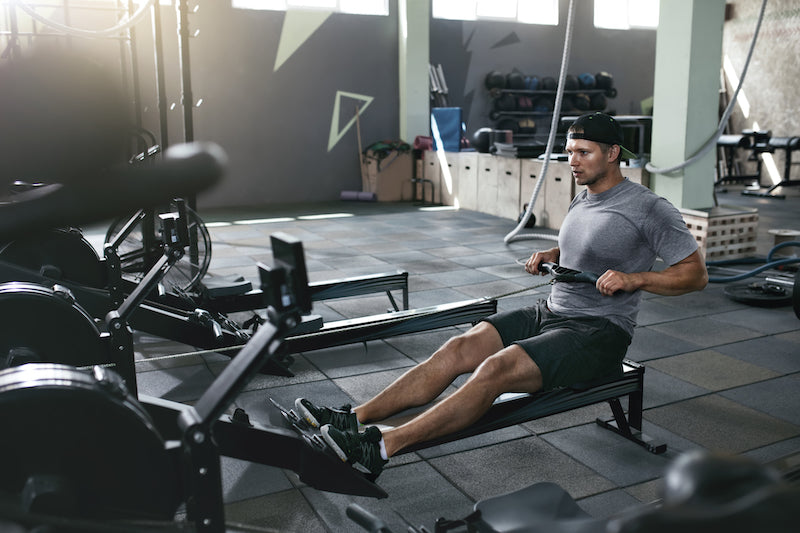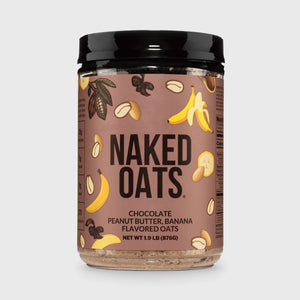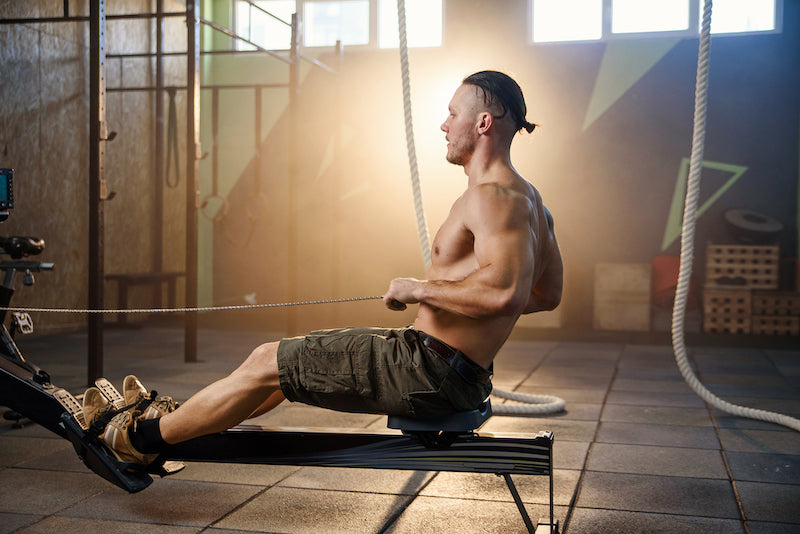
The benefits of cardio are well-established. It’s great for fat loss, cardiovascular health, mental health, cognitive performance, sleep, and more.
But there are many different types of cardio you can do, and all offer a little something different. When we think of cardio, we usually think of running. Yet the jury is out as to whether that’s the best form of cardio you can be doing.
On the other hand, rowing is an underrated, and overlooked form of cardio.
Rowing offers plenty of awesome benefits, and could be a great alternative for people who are used to running for cardio.
Read on and we’ll explain the benefits of rowing, as well as those of running, and break down which is the best for you.
Benefits of Rowing
Rowing offers some pretty nice benefits, on top of the main regular benefits of cardiovascular exercise. Let’s check them out:
Low-Impact Exercise
Rowing gives you a great cardio workout with very little impact on your joints. Unlike running, which can lead to issues with knees, ankles and hips, rowing puts all the stress on the muscles instead.
This makes it a great type of cardio for people with arthritis, or if you’re recovering from certain injuries.
Rowing Works the Whole Body

Rowing activates a large range of muscle groups, giving you a really efficient workout. You’ll work the arms, back, obliques, abs, and contrary to popular belief, your legs also get a decent workout. Not many activities work as much of the body as rowing does.
Rowing Boosts Power and Muscular Endurance
Alongside cardio, you can see solid gains in power and endurance from rowing.
You need to use strength and explosiveness to pull back during a rowing stroke, and the constant stress you put your muscles under is awesome for building endurance, which translates to greater performance in a lot of other physical activities or sports.
It’s Versatile
You can change up your rowing workout to achieve a bunch of different goals. If you want to focus mainly on cardio, lower the resistance level on the machine. Alternatively, increase resistance to focus more on strength and building muscle.
You can do slow, measured strokes, a short, high-intensity workout, or a long workout to boost endurance more. Rowing can fit anyone’s fitness routine, no matter your goals.
Good For the Core
Rowing is an excellent full-body core workout. It activates the abs and obliques, key muscles in the core, alongside all the other areas it targets. Best of all, it doesn’t just stabilize the core, it actually helps you build muscle in these muscle groups, which a lot of core exercises don’t do.
Rowing is Safe
There’s very little risk of injury or accidents when working out with a rowing machine. Some other forms of cardio, such as running or biking, can be risky (particularly when done outside). You can fall over, hit something, or get hit by something.
This makes rowing particularly good for people with poor vision, as you don’t need to worry about looking at what’s in front of you.
Benefits of Running

Make no mistake, running is not bad for you. There are some big benefits to running, whether it’s on the road or on the treadmill, including several ways in which it’s a better choice than rowing or other forms of cardio.
Let’s take a deeper look:
Running is Convenient
First, the biggest reason that running is a great form of cardio is that it’s convenient and accessible.
You don’t need any special equipment (other than a pair of shoes). You can do it anywhere - on the road, in the park, wherever there’s some open space to move. And if you’re at the gym, you can be pretty sure there’s going to be a treadmill or two.
That means there’s pretty much nothing stopping you from getting a run in, wherever you are, and whether or not you can get to a gym.
It’s Great for Cardiovascular Health
Running has proven and studied benefits on the cardiovascular system. The aerobic nature of running means it conditions this system better than most other forms of cardio.
Studies note that runners tend to be ahead in many markers of cardiovascular health, such as resting heart rate, healthier ventricles, and lower rates of coronary disease.
An Efficient Way to Burn Calories
All types of cardio help you burn calories, but some burn calories more efficiently than others.
Running is proven to be one of the most efficient out there, burning more calories than most other activities when done for the same amount of time at a relatively equal intensity.
Running Builds Lower Body Strength

Running is awesome at building strength all throughout the lower body. From the quads and hamstrings, to the glutes, to the calves, you’re getting a full workout below the waist when you run, which builds a ton of strength alongside the cardio benefits.
Running Improves Bone Density
The higher-impact nature of running is often touted as a negative. But it also means improved bone density.
The stress you put your body under when running forces higher production of hormones and minerals that improve the structure and density of your bones, which leads to a lower risk of fractures and breaks, as well as less risk of conditions like osteoporosis later in life.
For added protection to your joints, you can take a collagen supplement to maintain rock solid bone health.
Rowing vs Running: Which is Better?

To be sure, any type of cardio is better than no cardio. But if you’re weighing up the benefits of rowing vs running, here are some key areas where each comes out ahead.
- Impact on joints: rowing. There’s virtually no stress on the joints from rowing, whereas running can be troublesome for people with ankle, knee, or hip issues.
- Calories burned for weight loss: running. Running is more efficient for burning calories. If weight loss is your goal, running will probably provide faster results.
- Building muscle: rowing. You’re going to build more muscle, as well as strength, power and muscular endurance with the rowing machine.
- Full body workout: rowing. Rowing is a better all-round, full-body workout, as it targets the upper body as well as the lower body and core.
- Cardiovascular exercise: running. Running is a little better for heart and cardiovascular health. However, rowing is certainly a great choice in this aspect as well.
- Length of workouts: rowing. Rowing is better if you want to get a short, high-intensity workout whenever you have time.
Is Running or Rowing Better for Fat Loss?
If fat loss is your goal, you’re going to want to do something that efficiently burns calories.
For this, running generally comes out ahead. Doing each exercise at equal intensity, you’re going to burn more calories with running vs rowing.
A 155lb (70kg) person will burn approximately 492 calories in one hour of moderate rowing, while a fairly light run (at 6 miles per hour) over the same time will burn around 703 calories.
However, it’s worth mentioning that, as rowing is a lower-impact exercise, you may be able to do it for longer and more consistently without injuring yourself, meaning you’ll actually burn more calories over time due to a higher total workout volume.
It may also be better for toning the upper body, as opposed to simply burning calories overall.
Which One is Right For Me?
The best type of cardio will be different for each person. It depends on your goals, your access to equipment, the time you have available, and other factors like body type and injuries.
Generally speaking, if you want to boost cardiovascular health and burn calories, running is better. It’s also best if you have limited or no access to a gym since you can do it anywhere, with no equipment but a pair of shoes.
If you want a more varied, full-body workout, rowing is better. It’s not only great for cardio, but also for strength, endurance, and power.
You’ll strengthen both the upper and lower body, as well as the core. You’ve got the freedom to choose between different types of workouts - short, high-intensity workouts, long-endurance workouts, or high-resistance workouts focused more on building muscle and strength.
Rowing is better for anyone with injuries (particularly lower body, and joint-related injuries). It’s also better cardio for people with higher body weight since these people are likely to have more stress on the joints from running or jogging.
Ok, Rowing Sounds Great! How Do I Start?
To get started sith rowing, there are three things to consider.
- Do you have access to a rowing machine?
- How to row with proper form
- Select a rowing workout appropriate for your goals (cardio, HIIT, warmup, etc.)
We can't really help much with the first one other than to say look for one in your gym.
Or if you're really intrigued, you could join a gym that has one, or even go as far as buying one for your home gym.
That being said, let's look at the other two factors.
Number one, rowing form. Check out this video from Dark Horse Rowing, a great resource for rowers of all levels including beginners.
Once you got the form down, try this beginner rowing workout, also from Dark Horse Rowing.
Depending on your fitness level, this workout could range from super easy to quite intense.
But you can use this as to gauge your rowing fitness and calibrate your subsequent efforts accordingly.
Final Thoughts
Any type of cardio is better than no cardio. Regular aerobic workouts help you live longer, and improve performance in all other types of athletic activity.
For the best results, supplement your training with high-quality nutritional supplements, such as Naked Creatine, and boost your pre-workout energy levels with a clean pre-workout like Naked Energy.
As long as you’re doing some form of cardio regularly, you’ll be ahead of most people in terms of physical fitness. But if you want to take your fitness to another level, think about mixing up your regular treadmill workout, and try working out on the rowing machine.













